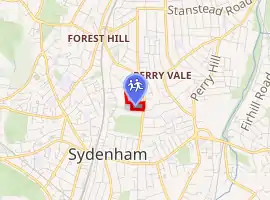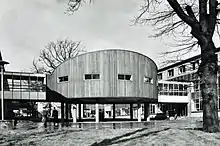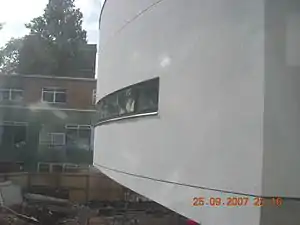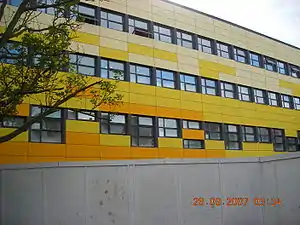Forest Hill School
Forest Hill School is a boys' secondary comprehensive school located in Forest Hill, in the London Borough of Lewisham. The school is in federation with the girls' secondary, Sydenham School, which is nearby.
| Forest Hill School | |
|---|---|
 The 'three schools' logo | |
| Location | |

| |
| , | |
| Coordinates | 51.4318°N 0.0477°W |
| Information | |
| Type | Community school |
| Established | 1956 |
| Local authority | Lewisham |
| Department for Education URN | 100745 Tables |
| Ofsted | Reports |
| Head teacher | Mike Sullivan |
| Gender | Boys (Girls in Sixth Form) |
| Age | 11 to 18 |
| Enrolment | 1360 |
| Houses | Ofosu-Asare (Red) Turing (Yellow) Parks (Light Blue) Tull (Green) |
| Publication | Our Voice |
| Website | foresthill |
In 2005 the school was given Performing Arts status for its Drama, Dance, Music and Art courses and currently has a silver artsmark from the English Arts Council.[1][2] The school is now often oversubscribed and the catchment area has recently been reduced by around 200 yards. The school has an Investors in People award.[3]
History
Forest Hill Comprehensive School opened in September 1956. It was built on the site of St. Magnus, a large house that was the home of Baron Johann Knoop from 1870 and 1900. In the Second World War it became a Heavy Recovery Centre, dealing with bomb damage. After the War it fell into disrepair.
The School was a flagship of the London County Council's new policy of building comprehensive schools that aimed to breakdown the previous national policy of selecting children, largely on 11-plus results, to attend grammar, technical or secondary modern schools. It eventually grew to around 1,500 boys.
The first head teacher was Alexander E. Howard, who was a leading national figure in technical education.[4] In its early years the school attracted considerable interest from educationalists. The following is a report of a visit to the school in July 1957 by the American educationalist Flaud C. Wooton.
I spent June 4, 1957, with William H. Perkins (Educational Director, Imperial Chemicals, Ltd., London) and John Aseltine (San Diego educator) at the London County Council comprehensive school at Forest Hill. That school was opened in September, 1956, and currently enrolls 900 to 1000 boys. Its buildings are new and among the best I saw last spring in eight countries of Europe. The teaching staff is relatively young, well trained, vigorous, and enthusiastic. Above all, the headmaster, Mr. A. E. Howard, in frank discussion, revealed educational ideas and described the school's purposes and practices with combined competence and optimism. As the English comprehensive school spreads, it will, if it lives up to ForestHill, brighten the future of secondary education in Great Britain.[5]

The academic quality of the early cadre of teachers is indicated by the careers that some went on to. Paul Ashbee became Professor of Archaeology at the University of Anglia. Laurie Taylor (sociologist) taught English and Drama and went on to a distinguished career in Sociology and is for his broadcasting. Brian Brookes, who taught Botany, went on to become a leading naturalist, with expertise in the plants of the Scottish Highlands, and environmental consultant, being awarded the MBE in 1983 for his services to education.[6] David Stanbury, who taught Biology and became the School’s third Headmaster, researched and wrote on Robert Fitzroy, the captain of HMS Beagle, on which Charles Darwin was naturalist.[7] Christ’s College Cambridge holds a collection of Stanbury’s papers.[8]
The School attracted press attention with many of its activities in the 1960s.[9] In 1962, the School organised a trip to the United States, which the Daily Mirror headlined: ‘An Exceptional School … With Exceptional Boys: 76 Ambassadors from London SE23’.[10] It was described as ‘a grammar, technical, commercial, central and modern school – all in one’, with one boy quoted as saying ‘None of the boys would change Forest Hill School for Eton.’ The school also had its own film unit and produced feature length films including Twenty Four Hundred Pennies (1962)[11] and The Custard Boys (1979)[12] which starred pupils and staff from the school.
In 2016 the school was forced to cut costs by an annual £1.3m, as funding had been cut as part of a political decision at Westminster.[13] The school has since stabilised its financial situation.
Current
In 2005 the school was given Performing Arts status for its Drama, Dance, Music and Art courses and currently has a silver artsmark from the English Arts Council.[14][15] The school is now often oversubscribed and the catchment area has recently been reduced by around 200 yards. The school has an Investors in People award.[16]
Houses
The four houses of Forest Hill are named after famous people of the 16th, 17th, 18th and early 20th centuries. While the house only initially determines which form the student is in, it also forms the basis of sport teams throughout each pupil's career at the school.
Originally there were six houses, but two were later dropped: Browning and Newton. When there were six houses Browning's house colour was red, Drake's dark blue, Reynold's light blue and Newton's maroon. The houses went on to become Drake (Red), Harvey (Yellow), Reynolds (light blue) and Shackleton (dark green).
However, after a review process that started in October 2019, the School decided it was time to update these houses to better reflect the diversity of the School and the surrounding community and modern values.[17] After a selection process including decision with students four new figures were selected as the house names. These were as follows: Ofosu-Asare (formally Drake), a former student of the school who tragically lost his life to knife crime due to mistaken identity,[18] Turing (formally Harvey), Parks (formally Reynolds) and Tull (formally Shackleton). These changes were put into effect in September 2020 in correlation with the new school year.

Redevelopment
Sports Hall
In 2006 the school's new £4.5M state-of-the-art sports facility was opened with lottery funding and help with Sport England and The FA Charter Standard Schools Program.[19] The facility features a large air conditioned sports hall with basketball nets, indoor cricket, indoor football markings and goals and a scoreboard. The other part of the gym includes a fitness suite, cafè, space for trampolining and table tennis, new changing room facilities with showers and also two of the old three gyms. The sports centre opened on top of Gym 3, but was also expanded towards Bampton Road on the other side of the school.
Main building

The school began a major redevelopment project in July 2006 which completed in January 2008.[20] The only part of the school which remains unchanged is the current art block, which was built recently. The rest of the school was demolished and rebuilt from the ground up with the three floor plan changed to a higher four story building. The new school building now features a huge atrium which doubles up into a fully functioning theatre, two fully equipped drama rooms, a separate theatre, a fully equipped music department with a Recording studio and a Mac computer room. There is also a dance studio with sprung floors, mirrors, and a 600 watt speaker system.
Notable people educated at Forest Hill School
- Brian Jacks, Olympic judo medalist and TV sports personality
- Andy Kane aka "Handy Andy", television DIY expert (Changing Rooms)
- Richard Rufus, footballer
- Glen Murphy (Pulse) of Twist & Pulse, street dancer
- Dave Courtney, former gangster and author
- Charlie Elliott, Freddi Hyde-Thompson and Joe Simpson of The Metros
- King Krule, award-winning musician
- Marlon King, played Premier League football for Watford, Wigan Athletic, Hull City
- Joe Gomez, plays Premier League football for Liverpool F.C. and Charlton Athletic
- Eman Kellam, YouTube and television personality[21]
- Sean Scully, contemporary artist, based in New York[22]
- Joe Absolom, actor
- Valentine Nonyela, actor and producer
- Kasey Palmer, footballer for Bristol City
- Manny Monthé, footballer for Tranmere Rovers
- James Ellington, Olympic athlete[23]
- Tom Toomey, Guitarist with the ZOMBIES 2019 Rock and Roll Hall of Fame inductees
References
- Specialist Schools and Academies Trust Archived April 9, 2007, at the Wayback Machine
- Artsmark Archived 2007-05-25 at the Wayback Machine
- Welcome to Investors in People
- A.E. Howard, ‘Technical Subjects in Secondary Schools’, Education + Training, 1 (1959), 7–9, doi: 10.1108/eb001539
- Flaud C. Wooton in History of Education Journal, Vol. 8, No. 1 (Autumn, 1956), pp. 28–30.
- A. Burns, ‘Obituary: Brian Brookes’, Watsonia, 24 (2001), 125–6; M Lawley, ‘Brian Sydney Brookes’, Journal of Bryology, 23 (2001) 345-345, DOI: 10.1179/jbr.2001.23.4.345
- D. Stanbury, A Narrative of the Voyage of H.M.S.Beagle, London: Folio Society, 1977.
- College Archives, Christ’s College Cambridge, https://www.christs.cam.ac.uk/current-students/college-archives
- ‘Full Marks … for “all-in” schools’, Daily Mirror, 24 October 1961; ‘Royal Cruise for 5 Boys and a Girl’, Daily Mirror, 17 April 1965, 3.
- Daily Mirror, 17 August 1962.
- https://www.bfi.org.uk/films-tv-people/4ce2b8908289a
- https://www.bfi.org.uk/films-tv-people/4ce2b70752c55
- Weale, Sally (18 July 2017). "One out, all out! The school where cuts are pushing teachers to the brink". The Guardian. Retrieved 22 July 2017.
- Specialist Schools and Academies Trust Archived April 9, 2007, at the Wayback Machine
- Artsmark Archived 2007-05-25 at the Wayback Machine
- Welcome to Investors in People
- "School Houses | Forest Hill School". Retrieved 4 October 2020.
- "Kwame Ofosu-Asare death trial: Innocent teen 'caught in gang feud'". BBC News. 27 November 2012. Retrieved 4 October 2020.
- TheFA.com – Charter Standard Schools
- http://www.foresthill.lewisham.sch.uk/new_build_gal.asp
- "Forest Hill's Emmanuel Olaniyan, 15, becomes Young Mayor of Lewisham". News Shopper. Retrieved 6 October 2020.
- Hester, Lacey (13 June 2014). "Interview with Sean Scully". Financial Times. Have you ever taken an IQ test?. Retrieved 6 October 2020.
- "Ellington is golden boy who Don good". News Shopper. 23 July 2003. Retrieved 15 January 2021.